Hydraulic Heavy Duty Puller: A Comprehensive Overview
Introduction
Hydraulic heavy-duty pullers are indispensable tools in industries that demand the removal of large and tightly secured components. These robust machines leverage hydraulic pressure to generate substantial pulling force, making them highly efficient for tasks such as dismantling engine blocks, gearboxes, and other heavy machinery components. Their ability to exert immense force with precision has made them essential equipment in various sectors, including automotive, industrial, and construction.
1. Structure and Working Principle
A hydraulic heavy-duty puller comprises several key components:
hydraulic pump: This component generates high-pressure hydraulic fluid, the driving force behind the puller's operation.
Hydraulic Cylinder: The hydraulic fluid is directed to this component, where it exerts pressure on a piston, causing it to extend and generate pulling force.
Control valves: These regulate the flow of hydraulic fluid, allowing for precise control over the pulling force.
Puller jaws: These are the interface between the puller and the component to be removed. They are designed to grip and extract the component safely and efficiently.
The working principle is relatively straightforward. When activated, the hydraulic pump creates high-pressure fluid that is channeled into the hydraulic cylinder. This pressure forces the piston to extend, causing the puller jaws to exert a pulling force on the target component. By manipulating the control valves, operators can fine-tune the pulling force to suit the specific task at hand.
2. Classification
Hydraulic heavy-duty pullers can be categorized based on various factors:
Based on Structure:
Single-Acting: These pullers utilize a single hydraulic cylinder for pulling.
Double-Acting: Equipped with two hydraulic cylinders, offering greater pulling force and versatility.
Internal puller: Designed for extracting components from within a housing.
External puller: Primarily used for pulling components from the exterior of a machine.
Based on Application:
General purpose: Suitable for a wide range of applications across different industries.
Specialized: Designed for specific tasks or industries, such as bearing pullers or gear pullers.
Based on Power Source:
Manual: Operated by human power, typically used for lighter applications.
Electric: Powered by an electric motor, offering greater pulling force and ease of use.
Pneumatic: Driven by compressed air, providing rapid and powerful operation.
3. Selection and Usage
Selecting the appropriate hydraulic heavy-duty puller is crucial for efficient and safe operations. Key factors to consider include:
Pulling force: The required pulling force should exceed the force needed to remove the component.
Stroke length: The distance the puller jaws can extend should be sufficient for the task.
Working environment: The puller should be suitable for the operating conditions, such as temperature and humidity.
Proper usage is equally important. Essential guidelines include:
Installation: Ensure the puller is securely mounted on a stable base.
Alignment: Precise alignment of the puller jaws with the component is vital to prevent damage.
Gradual application of force: Increase the pulling force gradually to avoid sudden stress on the component.
Safety precautions: Wear appropriate protective gear and follow safety guidelines.
4. Maintenance and Precautions
Regular maintenance is essential to prolong the life and performance of a hydraulic heavy-duty puller:
Hydraulic fluid: Check fluid levels regularly and replace them as needed.
Components: Clean and inspect components for wear or damage.
Seals: Replace worn seals to prevent fluid leaks.
Storage: Store the puller in a clean and dry environment.
Safety should always be a top priority when using hydraulic heavy-duty pullers:
Personal protective equipment: Wear safety glasses, gloves, and other appropriate gear.
Overloading: Avoid exceeding the rated capacity of the puller.
Stability: Ensure the puller and workpiece are securely supported.
Emergency procedures: Develop and communicate emergency procedures.
Conclusion
Hydraulic heavy-duty pullers are indispensable tools for removing large and tightly secured components. By understanding their structure, classification, selection, usage, and maintenance requirements, users can harness their power safely and efficiently. These machines have become essential assets in various industries due to their ability to handle demanding tasks with precision and reliability.
Why Choose SAIVS™ as Your Supplier?
With 20 years of industry experience, SAIVS is a leading Chinese manufacturer of high-quality tools, offering competitive pricing and excellent customer service.We pride ourselves on exceptional quality control, extensive experience, and comprehensive after-sales service.
